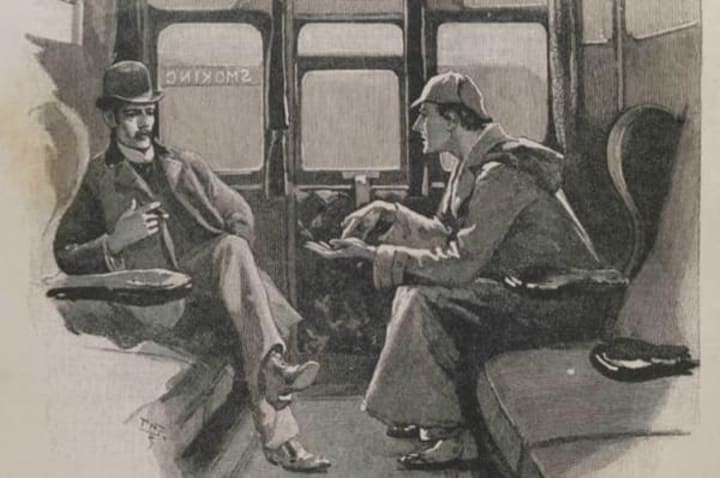
When George Lucas announced that he doesn't like Star Wars: The Force Awakens, fandom was shocked. But I think the reason he dislikes it is simple, and it's rooted in something very human; he's seeing that his baby has grown up, and he doesn't quite like it.
It doesn't happen often, but every now and again someone creates something that is greater than themselves. I want to explore that phenomenon, looking at how hard it is - using three critical examples...
1. Sherlock Holmes - when a creator goes to war with their creation!
Jeremy Brett, the greatest Sherlock Holmes!
When Sir Arthur Conan Doyle created the character of #SherlockHolmes, he had no idea that he was tapping into a vein of popular culture that had never been noticed before. The adventures of Sherlock Holmes were published as short stories in Strand magazine, and to Conan Doyle they were a diversion from the serious writing that he wanted to be known for. Unfortunately, to Conan Doyle's frustration, Holmes performed rather better than anything else he wrote.
Sherlock Holmes, you see, was very much the Victorian ideal. Cold and aloof, a creature of logic rather than passion, he was the man from whom no mystery could hide. It's telling that the majority of his opponents either came from overseas, or were somehow influenced by time spent there; you get a strong sense of British logic overwhelming the chaos of the wider world, bringing it into submission. Ironically, we tend to overlook that element of the Sherlock Holmes stories nowadays, blind to the social cues that really made Sherlock Holmes so popular at the time. People began to react to Holmes as though he were a real character, with presents, pleas for help, and even requests for an autograph!

Conan Doyle was furious with it, and, finally, he had enough. In The Adventure of the Final Problem, he had Sherlock Holmes die in battle with James Moriarty. Conan Doyle had intended this to be a sort of 'blaze of glory', Holmes successfully defeating the greatest criminal mastermind the world had ever seen, but fan reaction shocked him. Strand magazine lost twenty thousand subscriptions overnight, obituaries for Holmes appeared in all the newspapers, and the death was literally front-page news. Writing back to a friend who urged him to resurrect Holmes, Conan Doyle observed:
"I couldn't revive him if I would, at least not for years, for I have had such an overdose of him that I feel towards him as I do towards pâté de foie gras, of which I once ate too much, so that the name of it gives me a sickly feeling to this day."
But reality intruded. Conan Doyle's other writings performed badly, and it became clear that the public were not interested in more Conan Doyle - they wanted more Sherlock Holmes. So it was that Conan Doyle finally relented, and - in The Adventure of the Empty House - revealed how Holmes had survived the Reichenbach Falls.
It's a fascinating tale, pitting the creator against the created - and with the creator losing. If you're interested in the full story, I recommend an excellent article by Diane Duane. In the century since, Sherlock Holmes has ingrained himself in popular culture. The advance of technology has created countless new opportunities for him - from movies to radio shows to television series, Holmes has flourished, in ways that his creator could never have envisioned.
2. Superheroes - just who were their creators anyway?
It's usually easy to tell who wrote a book, but comics are a community effort. Until September 2015, it was only Bob Kane who was credited with creating #Batman. But Kane's design was vastly different to the one we know and love - he pictured a black domino mask, stiff black bat wings attached to the arms, and even a costume that was mostly red! Comic book fans have long looked to Bill Finger, an artist who worked with Kane, as the one who created the iconic Caped Crusader. In fact, Finger wrote Batman stories that fashioned him as a detective, and played a major role in the design of the Joker as well. But, with comics typically only giving credit to the writer of the first book to feature the character, Finger's role went below-the-radar for most until this year, when his granddaughter threatened a lawsuit and DC were forced to acknowledge his role. The Hollywood Reporter received this statement:
“Bill Finger was instrumental in developing many of the key creative elements that enrich the Batman universe, and we look forward to building on our acknowledgement of his significant role in DC Comics’ history... As part of our acknowledgement of those contributions, we are pleased to confirm today that Bill Finger will be receiving credit in the Warner Bros. television series Gotham beginning later this season, and in the forthcoming motion picture Batman v Superman: Dawn of Justice.”
Over at #Marvel, the distinctive 'Marvel Style' - in which the writer gave a rough outline, the artist produced the art, and the writer then worked in dialogue and descriptive text - blurred the lines still further. To this day, there's heated debate about just how much Stan Lee was truly responsible for creating some of his most celebrated characters!

In reality, any comic book has the potential to transcend its creator(s) - whoever they may be. This is because most characters are owned, not by the writer, but by the publisher. To write a character into the Marvel or #DC universe is to lose the rights to that character, and in the 1990s a new company - Image Comics - was founded that allowed creators to keep the rights to their creations. Even this wasn't free from controversy; Neil Gaiman and Todd McFarlane wound up in a legal dispute over the character Angela, with Gaiman gaining full ownership of the character in 2012. In a delightfully ironic twist, in 2013 he sold the ownership over to Marvel, and she's now been established as Thor's sister!

Because the rights to many superheroes reside with a company and not with a creative team, any creator is essentially a custodian - a participant in a relay race, holding the baton but always ready to pass it on. Some creators settle down for years (Chris Claremont's legendary 1975-1991 stint on the #XMen books springs to mind), while others only pen a single arc before moving on. But this means that key elements of the superheroes may develop that were simply never envisioned by the original creators. As an example, when Stan Lee came up with the idea of mutants, it was as an excuse to avoid telling superhero origin stories. It was Chris Claremont who turned the X-Men into a social commentary against prejudice, a theme that remains core to the X-Men to this day.
3. Star Wars - the franchise whose creator tried to hold on tight!

Star Wars: A New Hope was much more of a group effort than is commonly thought - the final script was worked on by Gloria Katz and Willard Huyck, while the famous opening crawl was heavily rewritten by Brian De Palma! The visual look-and-feel of the Galaxy Far, Far Away was shaped by Ralph McQuarrie's sketches, while cinematographer Gilbert Taylor resisted many of George Lucas' ideas for Star Wars: A New Hope.
Still, the fact remains that, from the ouset, Lucas had a vision for building something greater than himself. He invited representatives from Marvel Comics to view an early cut of the film, and commissioned Alan Dean Foster to ghost-write the novelisation published six months before the film's release. The idea paid off, with Star Wars becoming a broad franchise that transcended media.

Splinter of the Mind's Eye!
Lucas took an approach that made Star Wars something of an awkward creature; he established that all aspects of the so-called Expanded Universe - from the descriptive text on the packet of an action figure to the plot of the most obscure comic - were somehow canon. As the years passed, this naturally led to some conflict (there are only so many times you can tell the story of how the Death Star plans were recovered without causing contradiction, after all). These were usually explained away, and some stories were branded 'Infinities' (that is to say, 'unreal').
In a sense, the Expanded Universe was too popular! In the 1990s, Timothy Zahn kick-started a long-running series of novels, while Dark Horse published a range of popular comics. Lucas began to realise that there was still a market for Star Wars, and in 1993 announced that he was beginning work on the prequel trilogy. By this point, Lucas had pretty much unrestrained creative control - none of the bickering with Fox that had characterised the creation of Star Wars: A New Hope - and this shows in the finished products. As critic Drew Grant observed:
"Perhaps the absolute creative freedom director George Lucas enjoyed while dreaming up the flick's 'comic' relief—with no studio execs and not many an independently minded actor involved—is a path to the dark side."
Star Wars shifted to a new, more complex approach to canon - one in which Lucas' own vision was primary, while others who "played in his sandbox" were telling their own secondary stories. Anything in the Expanded Universe that contradicted Lucas' narrative was either 'Infinities' or explained away (and some pretty bizarre stories were told to explain some of these away!).
Lucas' prequels struggled to stand on their own two feet, not helped by stilted dialogue and a lack of chemistry between Hayden Christensen's Anakin and Natalie Portman's Padme. Even George Lucas described himself as "the king of the wooden dialogue"! Still, Star Wars: Revenge of the Sith brought a satisfactory close to the trilogy; although it contained many of the prequels' weaknesses, it moved to the climactic heart of the tale, and so was much more appreciated.

It's interesting to look at George Lucas' experience of Star Wars as a battle for control. The original concept was his, but as he gained too much control over the finished product, the Expanded Universe became overly complex and the quality of the films seems to slide. A good movie - such as Star Wars: A New Hope - is always a team effort, but Lucas seemed to forget that as the years went on. Finally, he sold the license to Star Wars over to Disney, and they started out by wiping out the Expanded Universe in order to tell their own tales.
If you look at Star Wars as a battle for control, it's little surprise that Lucas dislikes Star Wars: The Force Awakens. Now that Star Wars has been sold on to Disney, he no longer has any say in it at all, and can only act as a critical observer. In fact, Disney have deliberately chosen to ignore his plans for Star Wars Episode VII, which had been focused on a group of "very young characters". He described it well to Collider: "They're not going to do what I want them to do. And I don't have the control to do that anymore, and all I would do is muck everything up" Perhaps the most touching comment from Lucas was in an interview with the Washington Post:
"Now I'm faced with this awkward reality, which is fine. I gotta go to the wedding. My ex will be there, my new wife will be there, but I'm going to have to take a very deep breath and be a good person and sit through it and just enjoy the moment, because it is what it is and it's a conscious decision that I made."
To the man who thrived on shaping and influencing the universe he had dreamed of, that's probably quite a difficult thing.
So there you have it - just three examples of creations who have transcended their creator! It's not an easy thing when it happens, but it's fascinating to watch...
About the Creator
Tom Bacon
A prolific writer and film fan, Tom has a deep love of the superhero genre.






Comments
There are no comments for this story
Be the first to respond and start the conversation.